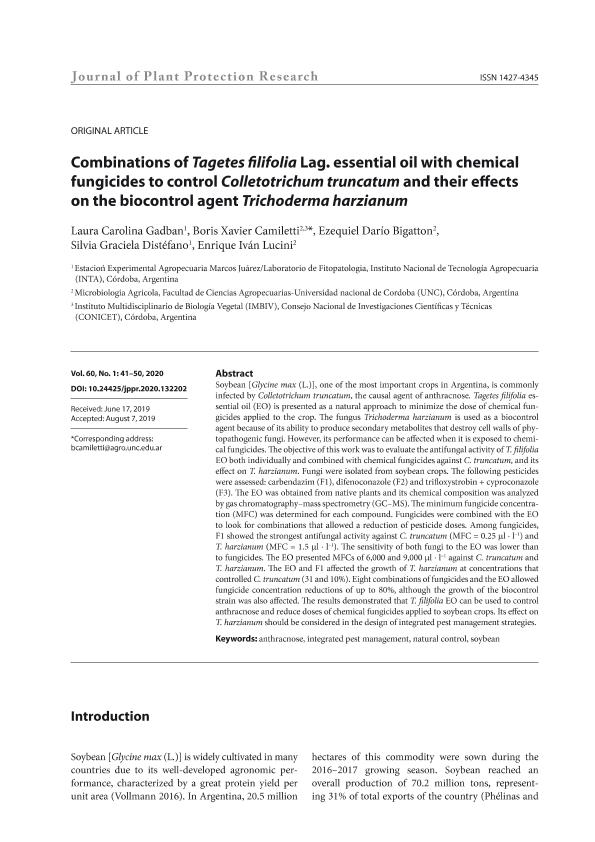Artículo
Combinations of Tagetes filifolia Lag: Essential oil with chemical fungicides to control Colletotrichum truncatum and their effects on the biocontrol agent Trichoderma harzianum
Gadbán, Laura Carolina; Camiletti, Boris Xavier ; Bigatton, Ezequiel Darío
; Bigatton, Ezequiel Darío ; Distéfano, Silvia Graciela; Lucini, Enrique Iván
; Distéfano, Silvia Graciela; Lucini, Enrique Iván
 ; Bigatton, Ezequiel Darío
; Bigatton, Ezequiel Darío ; Distéfano, Silvia Graciela; Lucini, Enrique Iván
; Distéfano, Silvia Graciela; Lucini, Enrique Iván
Fecha de publicación:
02/2020
Editorial:
Polish Academy of Sciences
Revista:
Journal of Plant Protection Research
ISSN:
1427-4345
e-ISSN:
1899-007X
Idioma:
Inglés
Tipo de recurso:
Artículo publicado
Clasificación temática:
Resumen
Soybean [Glycine max (L.)], one of the most important crops in Argentina, is commonly infected by Colletotrichum truncatum, the causal agent of anthracnose. Tagetes filifolia essential oil (EO) is presented as a natural approach to minimize the dose of chemical fungicides applied to the crop. The fungus Trichoderma harzianum is used as a biocontrol agent because of its ability to produce secondary metabolites that destroy cell walls of phytopathogenic fungi. However, its performance can be affected when it is exposed to chemical fungicides. The objective of this work was to evaluate the antifungal activity of T. filifolia EO both individually and combined with chemical fungicides against C. truncatum, and its effect on T. harzianum. Fungi were isolated from soybean crops. The following pesticides were assessed: carbendazim (F1), difenoconazole (F2) and trifloxystrobin + cyproconazole (F3). The EO was obtained from native plants and its chemical composition was analyzed by gas chromatography–mass spectrometry (GC–MS). The minimum fungicide concentration (MFC) was determined for each compound. Fungicides were combined with the EO to look for combinations that allowed a reduction of pesticide doses. Among fungicides, F1 showed the strongest antifungal activity against C. truncatum (MFC = 0.25 µl l–1) and T. harzianum (MFC = 1.5 µl l–1). The sensitivity of both fungi to the EO was lower than to fungicides. The EO presented MFCs of 6,000 and 9,000 µl l–1 against C. truncatum and T. harzianum. The EO and F1 affected the growth of T. harzianum at concentrations that controlled C. truncatum (31 and 10%). Eight combinations of fungicides and the EO allowed fungicide concentration reductions of up to 80%, although the growth of the biocontrol strain was also affected. The results demonstrated that T. filifolia EO can be used to control anthracnose and reduce doses of chemical fungicides applied to soybean crops. Its effect on T. harzianum should be considered in the design of integrated pest management strategies.
Palabras clave:
ANTHRACNOSE
,
INTEGRATED PEST MANAGEMENT
,
NATURAL CONTROL
,
SOYBEAN
Archivos asociados
Licencia
Identificadores
Colecciones
Articulos(CCT - CORDOBA)
Articulos de CTRO.CIENTIFICO TECNOL.CONICET - CORDOBA
Articulos de CTRO.CIENTIFICO TECNOL.CONICET - CORDOBA
Citación
Gadbán, Laura Carolina; Camiletti, Boris Xavier; Bigatton, Ezequiel Darío; Distéfano, Silvia Graciela; Lucini, Enrique Iván; Combinations of Tagetes filifolia Lag: Essential oil with chemical fungicides to control Colletotrichum truncatum and their effects on the biocontrol agent Trichoderma harzianum; Polish Academy of Sciences; Journal of Plant Protection Research; 60; 1; 2-2020; 41-50
Compartir
Altmétricas



